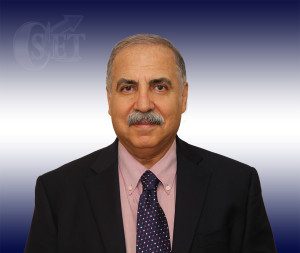Department of Chemistry, Physics, and Atmospheric Sciences – PHYSICS
College of Science, Engineering, and Technology
If you have ever wondered scientifically, “why” something is the way it is, or “how” can something exist or behave the way it does, then you’ve entered the realm of physics. Physics is the most fundamental of all sciences, and is the study of nature that is all around us. Physicists try to understand the most basic laws that govern the behavior of nature.
Ezat Heydari, Ph. D.

Contact:
Dept. of Physics, Atmospheric Sciences, and Geoscience
Jackson State University
P.O. Box 17660
Jackson, MS 39217
E-mail: ezat.heydari@jsums.edu
Phone: (601) 979-4230
Fax: (601) 979-3630
Education:
Ph.D. Louisiana State University 1990
M.S. Pennsylvania State University 1981
B.S. University of Tehran, Iran 1976
Research Interests:
Sedimentology and Stratigraphy
Petrography and Diagenesis
Low Temperature Geochemistry
Environmental Geology
Global Change
Publications:
(44). Heydari, E., Arzani, N., Safaeei, M., 2013, Ocean's response to a changing climate: Clues from variations in carbonate mineralogy across the Permian – Triassic boundary of the Shahreza section, Iran: Global and Planetary Change, in press.
(43). Heydari, E., 2010, Dolomites of the Smackover and Buckner Formations in the Mississippi Salt Basin: A key to Understanding Dolomitization Processes: Gulf Coast Association of Geological Societies Transactions, v. 60, p. 339 – 353.
(42). Heydari, E., Wynn, T. C., and Chen, Z. Q., 2010, Preface: Late Permian – Early Triassic Earth: Global and Planetary Change. V. 73, p. 1 – 2.
(41). Heydari, E., Arzani, N., and Hassanzadeh, J., 2009, Reply to comments on: “The invisible serial killer: Application to Permian – Triassic boundary mass extinction”: Palaeogeography, Palaeoclimatology, Palaeoecology, v. 293, p. 102 – 105.
(40). Heydari, E., Baria, L. R., 2008, A regional erosional surface and its effect on the Smackover reservoir – seal system, south Arkansas – north Louisiana: Gulf Coast Association of Geological Societies Transactions, v. 58, p. 381 – 395.
(39). Heydari, E., Arzani, N., and Hassanzadeh, J., 2008, The invisible serial killer: Application to Permian – Triassic boundary mass extinction: Palaeogeography, Palaeoclimatology, Palaeoecology, v. 264, p. 147 – 162.
(38). Baria, L. R., Heydari, E., Winton, B. G., 2008, Shale layers in the Alabama Smackover Formation and their implications for the relative sea-level change and regional correlation: Gulf Coast Association of Geological Societies Transactions, v. 58, p. 67 – 75.
(37). Heydari, E., 2008, Tectonics versus eustatic control on supersequences of the Zagros Mountains of Iran: Tectonophysics, v. 451, p. 56 – 70.
(36). Sorkhabi, R., and Heydari, E., 2008, Asia out of the Tethys: Forward: Tectonophysics, 451, 1 – 6.
(35). Heydari, E., and Baria, L. R., 2006, Reservoir Characteristics of the Smackover Formation at the Little Cedar Creek Field, Conecuh County, Alabama: Gulf Coast Association of Geological Society, v. 56, 283 – 289.
(34). Heydari, E., and Baria, L. R., 2006, Sequence Stratigraphy of the Smackover Formation in North-Central U.S. Gulf Coast: Gulf Coast Association of Geological Society, v. 56, p. 291 – 297.
(33). Heydari, E., and Baria, L. R., 2005, A microbial Smackover Formation and dual reservoir – seal system in the Little Cedar Creek Field in Conecuh County of Alabama: Gulf Coast Association of Geological Societies Transactions, v. 55, p. 294 – 320.
(32). Heydari, E., and Baria, L. R., 2005, A conceptual model for sequence stratigraphy of the Smackover Formation in north-central U. S. Gulf Coast: Gulf Coast Association of Geological Societies Transactions, v. 55, p. 321 – 340.
(31). Heydari, E., 2005, Reply to comments on the Permian –Triassic boundary interval in the Abadeh section of Iran with implications for the mass extinction: Part 1: Sedimentology: Palaeogeography, Palaeoclimatology, Palaeoecology, v. 217, p. 319 – 325.
(30). Heydari, E., and Hassanzadeh, J., 2003, Deev Jahi model of the Permian – Triassic boundary mass extinction: A case for gas hydrates the main cause of biological crisis on Earth: Sedimentary Geology, v. 163, p. 147 – 163.
(29). Heydari, E., 2003, Meteoric versus burial control on porosity evolution of the Smackover Formation: American Association of Petroleum Geologists Bulletin, v. 87, p. 1719 – 1737.
(28). Heydari, E., Hassanzadeh, J., Wade, W. J., And Ghazi, A. M., 2003, Permian -Triassic boundary interval in the Abadeh section of Iran with implications for the mass extinction: Part 1: Sedimentology: Palaeogeography, Palaeoclimatology, Palaeoecology, v. 193, p. 405 – 423.
(27). Heydari, E., and Keyes, M. 2003, Dolomitization of the Upper Jurassic Smackover Formation and hydrocarbon exploration in Mississippi: Gulf Coast Association of Geological Societies Transactions, v. 53, p. 323 – 338.
(26). Heydari, E., and Wade, W. J., 2002, Massive recrystallization of low-Mg calcite at high temperatures in hydrocarbon source rocks: implications for organic acids as factors in diagenesis: American Association of Petroleum Geologists Bulletin, v. 86, p. 1285 – 1303.
(25). Heydari, E., Wade, W. J., and Hassanzadeh, J., 2001, Diagenetic origin of carbon and oxygen isotope compositions of Permian-Triassic boundary strata: Sedimentary Geology, v. 143, p. 191 – 197.
(24). Heydari, E., 2001, Climatically controlled redox cycles of the Upper Cretaceous Mooreville Formation in Mississippi: Gulf Coast Association of Geological Societies Transactions, v. 51, p. 435 – 443.
(23). Heydari, E., Townsend, R., 2001, Fluvial sedimentation of Upper Jurassic Cotton Valley Group, Stringer Field, Jasper County, Mississippi: Gulf Coast Association of Geological Societies Transactions, v. 51, p. 109 – 120.
(22). Heydari, E., 2001, Porosity loss, fluid flow, and mass transfer in limestone reservoirs: application to the Upper Jurassic Smackover Formation, Mississippi: Reply: American Association of Petroleum Geologists Bulletin, v. 85, p. 1681 – 1683.
(21). Heydari, E., 2000, Sedimentological characteristics of the Upper Cretaceous Demopolis Chalk, Mississippi: Gulf Coast Association of Geological Societies Transactions, v. 50, p. 429 – 438.
(20). Heydari, E., 2000, Porosity loss, fluid flow, and mass transfer in limestone reservoirs: application to the Upper Jurassic Smackover Formation, Mississippi: American Association of Petroleum Geologists Bulletin, v. 84, p. 100 – 118.
(19). Heydari, E., Hassanzadeh, J., and Wade, W. J., 2000, Geochemistry of central Tethyan Upper Permian to Lower Triassic strata, Abadeh region, Iran: Sedimentary Geology, v. 137, p. 85 – 99.
(18). Heydari, E., Wade, W. J., and Anderson, L. C., 1997, Depositional environments, organic-carbon accumulation, and solar-forcing cyclicity in Smackover lime mudstones, northern Gulf Coast: American Association of Petroleum Geologists Bulletin, v. 81, p. 760 – 774.
(17). Heydari, E., 1997, The role of burial diagenesis in hydrocarbon destruction and H2S accumulation, Upper Jurassic Smackover Formation, Black Creek Field, Mississippi: American Association of Petroleum Geologists Bulletin, v. 81, p. 26 – 45.
(16). Heydari, E., 1997, Hydrotectonic models of burial diagenesis in platform carbonates based on formation water geochemistry in North American sedimentary basins, in Montañez, I. P., Gregg, J. M., and Shelton, K. L., eds., Basin-wide diagenetic patterns: integrated petrologic, geochemical, and hydrologic considerations: Society of Economic Paleontologists and Mineralogists, Special Publication 57, p. 53 – 79.
(15). Heydari, E., Byerly, G. R., and Henry, D. J., 1997, Contact metamorphism and over maturation of organic matter associated with an igneous intrusion in the Smackover Formation, northeastern Louisiana: Gulf Coast Association of Geological Societies Transactions, v. 47, p. 201 – 213.
(14). Dutrow, B., Henry, D. J., Christensen, C., Gable, C. W., Travis, B. J., and Heydari, E., 1997, Blackened Smackover: thermal evolution and mass transfer adjacent to a subsurface alkalic igneous dike in northern Louisiana: Gulf Coast Association of Geological Societies Transactions, v. 47, p. 131 – 139.
(13). Heydari, E., 1996, The fate of hydrocarbons in high temperature carbonate reservoirs: an example from the Smackover Formation, Black Creek Field, Mississippi, U.S.A.: Basin Research Institute Bulletin, v. 6, p. 51 – 59.
(12). Heydari, E., Wade, W. J., and Anderson, L. C., 1995, Depositional environments and accumulation of organic matter in the Smackover Formation, north-central Gulf of Mexico: Gulf Coast Association of Geological Societies Transactions: v. 45, p. 251 – 258.
(11). Gangopadhyay, T., and Heydari, E., 1995, Tectonic-sedimentation of the Atoka sandstones, Arkansas: Gulf Coast Association of Geological Societies Transactions, v. 45, p. 203 – 210.
(10). Heydari, E., and Moore, C. H., 1994, Paleoceanographic and paleoclimatic controls on ooid mineralogy of Smackover Formation, Mississippi salt basin: implications for Late Jurassic seawater composition: Journal of Sedimentary Research, v. A64, p. 101 – 114.
(09). Heydari, E., 1994, Depositional environments, ooid mineralogy, and porosity development of the Smackover Formation, Mississippi salt basin: Basin Research Institute Bulletin, v. 4, p. 39 – 51.
(08). Heydari, E., and Moore, C. H., 1993, Zonation and geochemical patterns of burial calcite cements: upper Smackover Formation, Clarke County, Mississippi: Journal of Sedimentary Petrology, v. 63, p. 44 – 60.
(07). Heydari, E., Snelling, R. D., Machain, M. L., and Dawson, W. C., 1993, Ooid mineralogy and diagenesis of the Late Mississippian Pitkin Limestone, north-central Arkansas, in Keith, B. D., and Zuppann, C. W., eds., Mississippian oolites and modern analogs: American Association of Petroleum Geologists Studies in Geology #35, p. 175 – 184.
(06). Moore, C. H., and Heydari, E., 1993, Burial diagenesis in platform limestones: a conceptual model based on the Upper Jurassic of the Gulf Coast, in Horbury, A. D., and Robinson, A. G., eds., Diagenesis and basin development: American Association of Petroleum Geologists Studies in Geology #36, p. 213 – 229.
(05). Heydari, E., and Moore, C. H., 1989, Burial diagenesis and thermochemical sulfate reduction, Smackover Formation, southeastern Mississippi salt basin: Geology, v. 17, p. 1080 – 1084.
(04). Meendsen, F. C., Moore, C. H., Heydari, E., and Sassen, R., 1987, Upper Jurassic depositional systems and hydrocarbon potential of southeast Mississippi: Gulf Coast Association of Geological Societies Transactions, v. 37, p. 161 – 174.
(03). Sassen, R., Moore, C. H., Nunn, J. A., Meendsen, F. C., and Heydari, E., 1987, Geochemical studies of crude oil generation, migration, and destruction in the Mississippi salt basin: Gulf Coast Association of Geological Societies Transactions, v. 37, p. 217 – 224.
(02). Heydari, E., 1986, Geology of the Resting Spring Pass Tuff: California Geology, v. 39, p. 253 – 261.
(01). Troxel, B. W., and Heydari, E., 1982, Basin and Range geology in a road cut, in Cooper, J. D., Troxel, B. W., and Wright, L. A., eds., Geology of selected areas in the San Bernardino Mountains, western Mojave Desert and southern Great Basin, California: Geological Society of America, Guidebook, p. 91 – 96.
LEARN BY DOING
Learn about the frontiers of space and time while searching for extrasolar planets and world-renowned observatories. Explore the mind-bending consequences of Einstein’s theory of gravity and curved space-time, or unlock the mysteries of our awesome Earth with field research opportunities.
“Challenging Minds, Changing Lives.”
RESEARCH
For many years, we have played a central role in new physics developments and advancements.
Want to learn more? Click below to view our advancements.
RESOURCES
PERSONNEL
READY TO JOIN?
For more information, please contact us at (601) 979-7012. We look forward to meeting with you and seeing how our program can help you achieve your goals.

